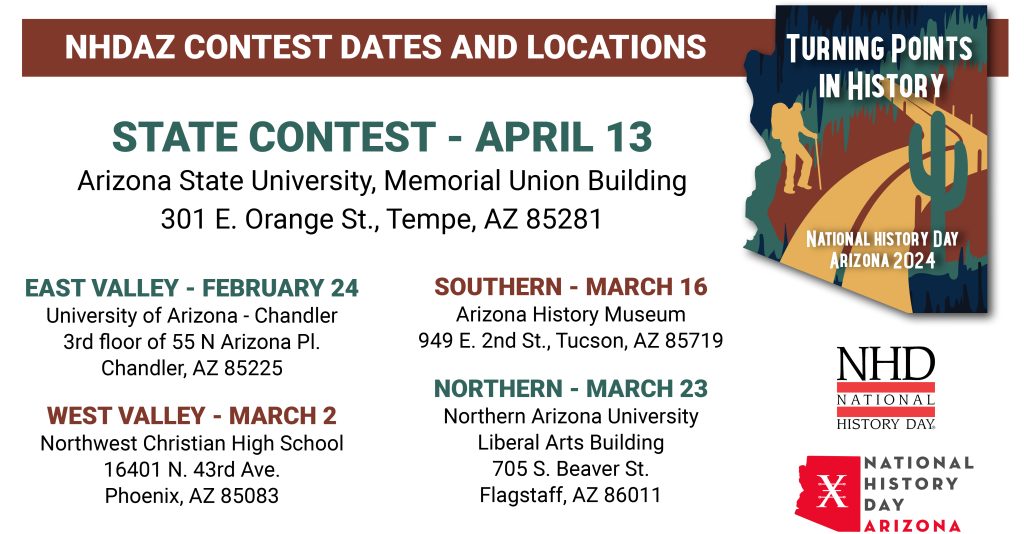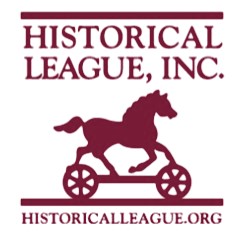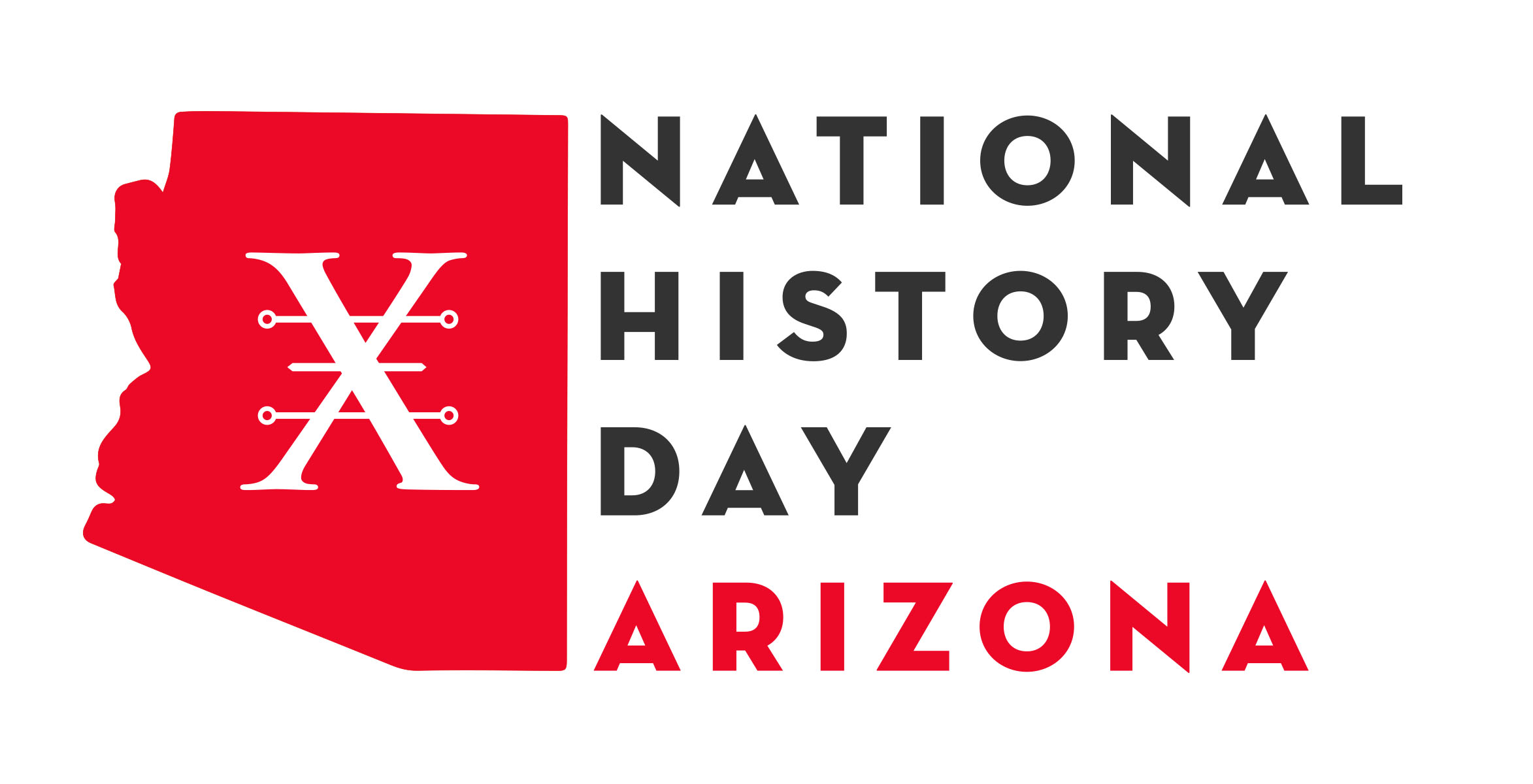Special Awards Nomination Process
Students who are promoted to the State competition can self-nominate or be nominated by their teacher. Students will self-nominate during the State competition registration. Teachers should notify the NHDAZ coordinator of students they would like to nominate for the awards. Students can only be nominated for TWO AWARDS. The project that the students submit to the NHDAZ State competition is the project that the special awards committee will evaluate. Students must write a justification for nominating themselves for awards. Unless otherwise specified, NHDAZ will select Special Awards Judges to choose winners. Students selected for awards will be notified at the State Award Ceremony.
1. Best Middle-Eastern or Northern African History Award
Sponsor: Center for Middle Eastern Studies
For Junior or Senior Division, group, or individual projects. One $150 prize. Projects nominated for this award must relate to the annual theme, Turning Points in History, and incorporate histories from the Middle East or Northern Africa. Best entries in the category include but are not limited to ancient, social, cultural, technological, or political history within the Middle East/Northern Africa.
Virtual workshop scheduled for November 7th at 4:00pm – Register here: https://us02web.zoom.us/meeting/register/tZAkcOirqj0oEtFfC9AZALc0PygtsBlx5-bl
2. Babbitt’s Family Award – Best WWI or WWII Entry
Sponsor: Babbitts Family Babbitts Family Award
For Junior and Senior Division, group, or individual projects. One $200 prize. Projects nominated for this award must relate to the annual theme, Turning Points in History, and the histories of either World War I or World War II. Best entries in the category include but are not limited to military, social, cultural, technological, or political histories. There is no preference for a place, but the period of study must be within the standard periodization of the World Wars, from about 1914 to about 1945.
3. Equality in History Project
Sponsor: Arizona Historical Society
For Junior and Senior Division, group, or individual projects. Two $150 prizes Projects nominated for this award must relate to the annual theme, Turning Points in History, and the histories of underrepresented people. The best entries for equality in history include but are not limited to the exploration of a historical topic or event, a bibliographic project, or a project that focuses on the contribution, accomplishments, experiences, and perspectives of People of Color, Indigenous People, members of the LGBTQIA+ community, children, and other underrepresented groups. Projects can also explore the efforts of underrepresented groups and their allies in the fight to have the same status in certain respects , often including civil, voting, and property rights, freedom of speech, marriage and gender equality, and equal access to social goods and services.
4. Best Women’s History Project
Sponsor: Arizona Historical Society
For Junior and Senior Division, group, or individual projects. Two $150 prizes Projects nominated for this award must relate to the annual theme, Turning Points in History, and women’s history. The best entries in women’s history include but are not limited to a gender-based exploration of a historical topic or event, a bibliographic project about a woman or women, or a focus on the contribution, accomplishments, experiences, and perspectives of women.
5. Best Use of Oral History
Sponsor: Southwest Oral History Association
For Junior or Senior Division, group, or individual projects. One $100 Prize The Oral History Award encourages junior and senior division students to include oral histories in their research as primary sources.
6. Best Arizona History Entry
Sponsor: Roe Family
For Junior and Senior Division, group, or individual projects. Two $200 prizes Projects must relate to the annual theme, Turning Points in History, and the history of Arizona, including Arizona before 1530, Spanish Arizona, Mexican Arizona, and the New Mexico Territory before 1863.
7. Best Jewish History Entry
Sponsor: Arizona Jewish Historical Society
For group and individual projects in all divisions. One $250 cash prize Projects must relate to the annual theme, Turning Points in History, and cover topics involving Jewish heritage, history, or individuals.
****Virtual Workshop scheduled for December 5th at 4:00pm. Register here: https://us02web.zoom.us/meeting/register/tZctceupqT8uH92qNtqUgnducI4DWLsGvH0a
8. Best Holocaust History Entry
Sponsor: Phoenix Holocaust Association
For group and individual projects in all divisions. One $250 cash prize Projects must relate to the annual theme, Turning Points in History, and the history of the Holocaust. Projects selected for this award must be specifically about the Holocaust or memory of the Holocaust.
9. Best in Western United States History
Sponsor: Charles Redd Center for Western Studies
For Junior and Senior Division, group, or individual projects. Two $100 Prize Projects nominated for this award must relate to the annual theme, Turning Points in History and Western history. Projects selected for this award must involve the histories of the Western United States: Arizona, New Mexico, Colorado, and Utah.
10. Historical League Award for Best Arizona Historymaker™ Project
Sponsor: Historical League
For Junior and Senior Division, group, or individual projects. Two $150 prizes Projects nominated for this award. Projects nominated for this award must relate to the 2024 annual theme, Turning Points in History incorporating either an Arizona Historymaker’s story as viewed at www.historicalleague.org/historymakers or an untold or under-told Arizona story. Historical League judges will select the award winner.
11. Historical League Best History Arizona Women’s History Project
Sponsor: Historical League
For Junior and Senior Division, group, or individual projects. Two $150 prizes Projects nominated for this award. Projects nominated for this award must relate to the National History Day 2024 annual theme Turning Points in History incorporating either an Arizona Herstory or the story of an Arizona woman Historymaker as viewed at www.historicalleague.org/historymakers. Historical League judges will select the award winner.
12. Best Government History Entry
Sponsor: Stephanie Mahan
Projects nominated for this award must relate to federal, state, or local government history; this can include all branches of U.S. government. The prize is awarded to the best entry in any category, in either division, which illuminates the history of the American federal, state, or local government.
13. Best African American History
Sponsor: African American Museum of Southern Arizona
This award is given in recognition of demonstrated excellence in the study of African American history. The prize is awarded to an outstanding student project in both the Junior and Senior divisions for $150 that documents and analyzes the African American experience. The subject(s) can be an individual, group(s), a right, challenge(s), triumph(s), or any topic that has historical significance, influence or impact. The project should explain why the subject(s) is/are important and place it/them in historical context.
14. Best Use of Archives Award
Sponsored by Arizona Archives Alliance
For group and individual projects. One Senior and one Junior division prize will be awarded.
The Best Use of Archival Collections Award encourages students in both the junior and senior divisions to include in their research those primary source materials either created in or held in an archival repository that represent a first-hand account contemporaneous with their chosen topic. These awards are intended to recognize projects that have utilized archival collections in a substantial way and encourage students to become familiar with archives and archival institutions.
15. Best Entry for Arizona Family History or Ethnic History
Sponsored by the Arizona Genealogical Advisory Board
For Junior and Senior Division, group, or individual projects. One $100 Prize
Projects nominated for this award must relate to pioneers who were in the area known as Arizona prior to statehood, 14 February 1912. It is important to collect and archive family histories or ethnic stories for future generations.
NHDAZ Special Awards Rubric







